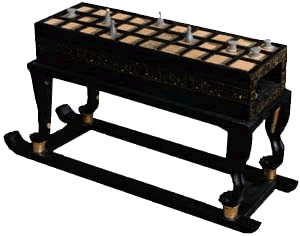Senet

Senet is a popular two-player board game in ancient Egypt, enjoyed by both commoners and nobility, that may be an ancestor of modern backgammon. The rules are not known, though about 40 sets have been found in tombs, some in very good condition, together with paintings of games on tomb walls, dating back to the reign of Hesy (c. 2686–2613 BC).
Senet, or the "game of passing," was played on a rectangular board consisting of three rows of 10 squares called "houses" that represented good or bad fortune The board could be a grid drawn on a smooth surface, or an elaborate box of wood and other precious materials. A perfectly preserved traveling version of Senet was found in Tutankhamen's tomb. The pieces, called ibau ("dancers" in Egyptian), varied in number from five to ten per player-five and seven being commonest. Cone-shaped pieces were pitted against reel-shaped pieces. The object was to get one's pieces on the board, then around the board in an S-shaped pattern, and finally off again at the far end. Strategy was mixed with chance (as it is in backgammon), introduced by the throw of four, two-sided sticks (as depicted in the Hesy painting) or, in later times, of knucklebones. Later depictions of the game, in the New Kingdom period, often showed just one player in competition-the opponent being a spirit from the afterlife. This has been interpreted as a change in the significance of Senet, from a simple amusement to a symbolic representation of the deceased's journey through the underworld.


